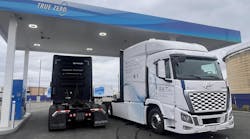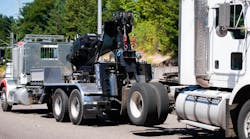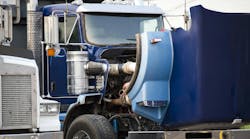The way in which trucks share the road with pedestrians, cyclists, and other vehicles is a point of constant concern and debate. Most truckers would love to drive on "Truck Only" highways, just as most automobile drivers would rather not share the road with trucks. Meanwhile, thousands die every year in trucks and truck-related crashes.
Although the number of large trucks involved in fatal crashes has been steadily declining over the past 10 years, over 5,000 people died in truck-involved accidents last year, according to a DOT study. About one-third of those accidents involving more than one vehicle took place in the "No-Zone" - the blind areas surrounding the truck.
While many people advocate educating the surrounding drivers to stay clear of these blind areas, responsibility to improve visibility and safety must finally lie with truck manufacturers and owners.
In many industries, this is already happening. Waste Management, the world's largest solid waste hauler and an innovator in vehicle safety, has been using rear-vision cameras for the past 20 years. They now have cameras installed on the majority of their route vehicles.
State and federal legislators are moving toward mandatory visibility standards in some industries. In mining, regulators have proposed mandatory rear-vision systems, even if radar and sonar alarms are already in use. In the state of Washington, all cargo-box delivery trucks over 18-ft. long are required to have backup warning devices or visibility enhancements.
These changes reflect the importance of blind-spot removal, and the steps being taken to improve operator visibility. In a recent Florida lawsuit, a truck body company was hit with a $25-million wrongful death verdict because it failed to equip a dump truck that was involved in a fatal backing accident with a backup device.
Route trucks have a special vulnerability. Operated at slow speeds in crowded alleys and parking areas, route trucks tend to attract small children. According to a recent NHTSA study, about 100 children of ages 1 to 4 are killed each year by backing vehicles.
It is crucial that the operator be able to see behind his vehicle before putting it in motion. Knowing this, many companies instruct their drivers to avoid backing up whenever possible, and to use a spotter when they absolutely must back up. In some instances, this is like looking down the barrel of a gun to see if it's loaded. In highway construction, for example, the spotter was the victim in over 12% of work zone fatalities.
Rear-vision camera systems have proven to be the most effective solution. As the originator of vehicle camera technology, Intec Video Systems manufactures camera systems that provide drivers with a high-resolution view of the entire area behind the truck.
According to Intec sales manager Roy Barbatti, "Every other technology leaves something to chance. Mirrors, sensors, beepers - they either rely on the other person for safety or cover an insufficient area." The Intec system provides a wide viewing area with a minimum of distortion, allowing drivers to see clearly, as if they were standing on the back bumper.
From the driver's point of view, the best tool in the toolbox is improved visibility. Eliminate the blind spot and let drivers see for themselves.


